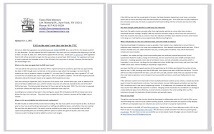 As our blog discussed more than a week ago, DOE announced that McGraw Hill will provide the new periodic assessments -- the same company that came up with the infamous Brownie the Cow.
As our blog discussed more than a week ago, DOE announced that McGraw Hill will provide the new periodic assessments -- the same company that came up with the infamous Brownie the Cow. According to the DOE, schools must give five assessments per year in grades 3-8 and four in High School in ELA and Math. More subjects will come later.
These tests will cost $80 million over five years and are separate from the state tests that are already required in grades 3-8. This, plus the cost of the ARIS supercomputer (another $80 million) could have paid for a whole lot of smaller classes. According to the New York Times,
“…few major cities administer standardized tests as frequently as five times a year, several education experts said, and the move instantly drew criticism from the array of groups that have mobilized against the growing reliance on standardized tests that has accompanied the No Child Left Behind law.
“It’s certainly more than any other city than I know of,” said Monty Neill, an executive director of the National Center for Fair and Open Testing in Boston, which is skeptical of standardized testing. “We’ve reduced schooling to preparing for bubble tests.”
Randi Weingarten, the president of the United Federation of Teachers, said in an interview that many teachers say they already spend at least one day a week preparing for standardized tests. “Our issue is, how much teaching time is this eating up?” she said. “You’re spending a lot of time doing test prep and doing paperwork associated with test prep instead of teaching.”
What’s the justification?
“I don’t think it means more pressure,” Mr. Klein said. “I think it means more learning.”
When did more testing become more learning? In the jargon of the Accountability office, more test results supposedly allows for more “differentiated” instruction “ which will lead to more learning.
Yet the smaller classes that would really make individualized instruction more possible are not considered. Instead, DOE has omitted the crucial step of improving classroom conditions – because mandating more testing will somehow substitute for everything else.
Apparently DOE could find only one principal in support of the new assessments: Elmer Myers, of PS/MS 194 in the Bronx. He is quoted in both the Daily News and NY1.
"This gives much more specificity from what I've seen for far, than what we've had in the past,” said Elmer Myers, a Bronx school principal. “We'll be able to take that information, sit down as a professional development team, and design ways we can improve instruction in a classroom."
According to Insideschools, Meyers is a new principal this year. The school’s report card shows that 14% of the students at PS/IS 89 are black, 64% Hispanic, 17% Asian, and 93% are eligible for free lunch.
According to the DOE, class sizes at the school range from 24.6 students in Kindergarten to 31.7 students per class in 4th grade. Sixth to eighth grade classes range from 27.4 to 29.8 students, with each middle school teacher usually responsible for five classes.
That means every middle school teacher has about 150 students, with charts to be analyzed for each class in different eye-glazing, color-coded categories five times a year. (See p.19 of this pdf file for an example of a class of only 17 students.)
Then, the revealed weaknesses of each of these 150 students will somehow addressed – that is, if the results are meaningful at all, which they won’t be, according to many testing experts and the record of the previous version from Princeton Review. And, of course, this will also depends on there being sufficient time in class to do so, along with all that test-taking.
Good luck to Mr. Myers, his teachers and most of all, the students at this school.
(For more information on the periodic assessments, see the DOE website here.)
 Word is the response rate on the parent survey is so low that DOE will extend the deadline once again. They are now openly threatening principals that if they don't get parents to return them in greater numbers this may count against their schools in their grades, which in turn could put their jobs at risk. In turn, principals are begging parents to fill in their surveys and send them back.
Word is the response rate on the parent survey is so low that DOE will extend the deadline once again. They are now openly threatening principals that if they don't get parents to return them in greater numbers this may count against their schools in their grades, which in turn could put their jobs at risk. In turn, principals are begging parents to fill in their surveys and send them back.



































